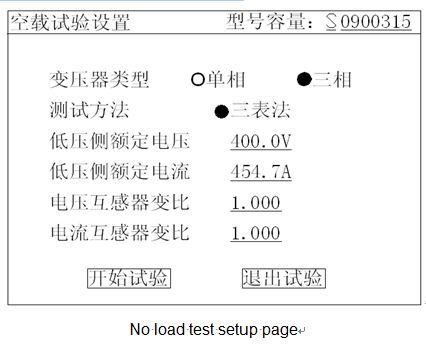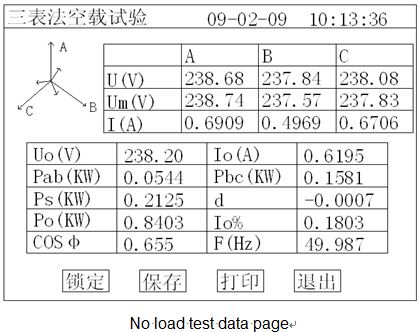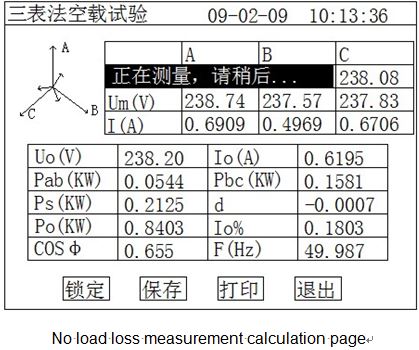No load test process of transformer capacity and no load tester
Release Time : 2018-06-14 View Count : 次ZC-202B transformer capacity and no load tester is a new type of instrument specially designed for the problem of bad power users to evade basic electricity charges and increase capacity without permission. It is a high-precision instrument for measuring transformer capacity, no-load, load and other characteristic parameters. This instrument is a multi-functional measuring instrument, equivalent to the usual two kinds of testing instruments: transformer capacity tester + transformer characteristic parameter tester. It can precisely measure a series of power frequency parameters such as capacity, type, no-load current, no-load loss, short-circuit (load) loss, impedance voltage and so on.
According to the type and test method of the transformer, refer to the corresponding wiring diagram for correct wiring, and then turn on the working power supply of the instrument.
Select no-load test in the main interface to display the no-load test setting interface as shown in the following figure:

This page saves the setting value of the last test, check and modifies the setting value in this page to make it consistent with the current test transformer.
Note: in some versions of our instruments, in order to simplify the external wiring, double meter method or three meter method has been connected inside the instrument. At this time, the test method of the interface is not optional, and the wiring of the instrument can only be connected according to the wiring method of double meter or three meter method.
In the above figure, select "start test" with the cursor, and press OK to enter the following no-load test data page:


The above figure completely shows all the test results of no-load test: Uo (V) is the average value of three-phase line voltage, Ps (KW) is the measured power under the current voltage, d is the voltage waveform distortion coefficient, Po (KW) is the corrected no-load loss, Io% is the percentage of no-load current.
The upper left side is the vector diagram of test voltage and current. If the wiring is wrong, the page will prompt "wiring error, please shut down and check"; slowly increase the test voltage through the voltage regulator, and stop boosting when Uo (V) is equal to the rated voltage of no-load test. Move the cursor to the "lock" button, and press the OK key for a long time. At this time, keep the voltage regulator still. When the prompt message of measurement in Figure 10 disappears, the current test result has been locked, and then the "lock" button becomes the "retest" button. At this time, please quickly operate the voltage regulator to depressurize to zero.
The "save" on the page saves the current results to the random memory; the "print" button prints the current test results through the printer.
Note: in the process of boosting voltage, attention should be paid to Uo and Io at all times. In addition to avoiding over-voltage, it is also necessary to pay attention to the damage of instrument or test object due to excessive test current when the test object is abnormal.
The printing function can only be used when the instrument is powered by an external power supply; when the instrument is powered by an internal battery, the printer cannot work. If there is no external power supply on site, the test results can be saved to the internal memory of the instrument, and the saved test records can be printed when the external power supply is available.
Press "retest" to retest the current transformer, and press "exit" to return to the main interface of system function in Figure 2.






